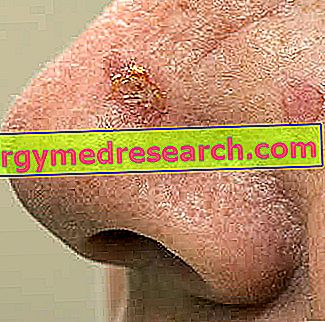What is Actinic Keratosis
Actinic keratosis is a skin lesion, a disease that involves the areas affected by excessive sun exposure and ultraviolet rays in general: not surprisingly, actinic keratosis is also called solar keratosis .

See other Actinic Keratosis Photos
Actinic keratoses are skin lesions of dermatological interest: they can in fact lead to cancerous forms such as squamous cell carcinoma (spinalioma) and basal cell carcinoma (basalioma).
Incidence
Actinic keratosis is a disorder related in part to the age and partly to the phototype of the subject: it affects 60% of light-skinned individuals over the age of 40, and 80% of the elderly over 60: it is therefore a widespread condition that can also affect young people who are increasingly exposed to exposure to artificial UV rays for an impeccable tan even in winter. Not surprisingly, this type of injury is considered to be the most common form of skin precancerous.
Actinic keratoses are a rare condition in the black race and in subjects with a high phototype (IV-VI).
Although actinic keratosis may also occur in women, current estimates show that this pathology manifests itself with a slightly greater incidence in men. An explanation of this fact could be due to the tendency of many male exponents to expose themselves to the sun for prolonged periods without applying sunscreen.
Causes
Causes and risk factors for Actinic Keratosis
Both at an experimental and epidemiological level, ultraviolet rays are the cause that causes actinic manifestation. Radiation accelerates skin photoaging: this hypothesis has been demonstrated by the fact that the skin, in addition to presenting actinic keratoses, is also accompanied by wrinkles, neoplasms, solar freckles and freckles, typical events determined by UV irradiation .
It seems paradoxical that older people complain of actinic keratoses at a time when sun exposure is reduced, almost absent. The explanation is simple: solar keratoses represent a cumulative phenomenon, which means that over the years UV radiation "accumulates" in the skin - which acts as a sponge - and the explosion of the disease can occur suddenly, even if the subject has not been subjected to a tan for some years. The sun exposure that contributes to actinic keratosis, however, can also be involuntary, in the sense that even walks, construction and agricultural works can represent the cause that, even many years after having ceased working, triggers the disorder.
A connection between actinic keratosis and immunodepression has been demonstrated: the alteration of the immune conditions of the subjects (for example those who have undergone an organ transplant) could favor the progression of solar keratosis in tumor, accelerating the time of malignant evolution.
Finally, in certain cases, actinic keratosis could be the consequence of prolonged exposure to particular chemicals or X-rays.
Features
Signs and characteristics of Actinic Keratosis
In general, actinic keratoses occur mainly at the level of the face (especially in auricles, forehead and lips), legs, arms, back of hands and scalp (in bald subjects), that is, in all those areas most exposed to the sun.
Actinic keratosis occurs in the form of erythematous scales, normal in color, pigmented with yellow or greyish and surrounded by a red halo and telangiectasias.
The lesions caused by solar keratosis are more evident to the touch, rather than to the sight, because the scales are rough and the area presents relief papules. This occurs above all in the initial phase of the development of the disease, since the lesions are so small as to be perceived with difficulty through a simple glance. However, the development of lesions occurs very slowly, but these can increase their size to reach 3-6 millimeters in size.
It should be remembered that actinic keratoses should not be confused with seborrheic keratoses: the latter represent a benign condition that cannot result in neoplasia.
Symptoms
To learn more: Actinic Keratosis Symptoms
In general, actinic keratoses are asymptomatic; as such, they have no obvious effects, except a feeling of itching or, in some cases, of tension.
In addition to this symptomatology, actinic keratoses can become inflamed, giving rise to the skin redness that often surrounds them.
Finally, in very rare cases, skin lesions can bleed.
Evolution
Evolution and complications of Actinic Keratosis
As mentioned, actinic keratosis can evolve and become complicated in a malignant tumor form.
Fortunately, in the majority of patients, actinic keratosis remains a benign lesion that does not cause problems.
In some cases, there has been a natural involution of actinic keratosis, while in others it has been noted that keratosis does not evolve and does not disappear, but remains in the same form in which it occurred.
However, despite this, it has been estimated that approximately 10% of patients suffering from actinic keratosis have undergone the malignant evolution of the disease.
In addition to this, it has been estimated that approximately 50% of squamous cell carcinoma cases have started starting from untreated actinic keratoses. It is immediately clear, therefore, how important early diagnosis and timely treatment of injuries is.
Differential diagnosis
The diagnosis of actinic keratosis is absolutely important, because it is possible that the skin disorder evolved into a malignant form: in this regard, actinic keratosis was evaluated as keratinocyte intraepithelial neoplasia . However, as already mentioned, actinic keratosis is not considered a tumor, but a precancerous form: therefore, it does not necessarily turn into neoplasia, although there is a certain probability in this regard. For this reason, the specialist must correctly diagnose the dermatological disorder before it becomes a malignant form.
Care
To learn more: Drugs to treat Actinic Keratosis
Following the diagnosis, carried out by the dermatologist or a specialist, the patient must undergo the final therapy.
The therapeutic approaches to eliminate actinic keratosis are different. The choice of a treatment method rather than another, of course, lies with the specialist who will prescribe the therapy that best suits each patient on an individual basis.
The pharmacological treatment of actinic keratosis involves the administration of drugs topically, to be applied directly on the area affected by the lesions. Among the active ingredients most used in this area, we recall:
- Diclofenac in 3% gel in combination with hyaluronic acid;
- 5-fluorouracil (5-FU) in ointment in concentrations ranging from 0.5% to 5%;
- The 5% immiquod in cream.
Among the possible resolving treatments - more or less invasive - we recall:
- Surgical excision;
- Photodynamic therapy;
- Cryotherapy (treatment with liquid nitrogen);
- Laser-therapy.
Furthermore, in cases where it is deemed appropriate, the specialist doctor may decide to subject the patient to a combination of the aforementioned therapies (for example, taking 5-FU followed by cryotherapy), in order to increase the probability of healing, and to reduce any side effects.
Photodynamic therapy
Photodynamic therapy for the treatment of actinic keratosis deserves further study: it is known by the acronym PDT and represents an innovative, non-surgical therapy aimed at eliminating the cancerous and pre-cancerous forms of the skin. The technique consists of a chemical process carried out by light (photochemical therapy): the light is absorbed by a photosensitive substance, with the formation of ROS (reactive oxygen species that destroy the cell within which they were formed). As a result, the pre-neoplastic cell dies. The photosensitive substance - or photosensitizer - is applied to the skin, penetrates and identifies the diseased cells. These substances are drugs that, with light, are activated, triggering the photochemical reaction that leads to the death of diseased cells (in this case affected by actinic keratosis).
Prevention
It is a good practice to adopt techniques to prevent a possible actinic keratosis, which should be all the more careful and scrupulous the greater the predisposition of the subject (low phototype, work activity outdoors, continuous exposure to the sun, etc.): the use of creams with sunscreens and protective clothing (such as, for example, the hat, especially for the bald) seem trivial tricks, but they represent a very valid form of prevention.
Summary
To fix the concepts ...
| Disease | Actinic keratosis or solar keratosis: involves areas affected by UV radiation (solar or artificial). It is a pre-carcinogenic form that could lead to basalioma or spinalioma. |
| Etymology of the term | "Keratosis" indicates an abnormality of the normal keratinization of the stratum corneum of the skin, which becomes thicker and more irregular. The actinic name, on the other hand, which derives from the Greek ακτίνα, literally means " ray ", caused by radiation. |
| Clinical picture | Erythematous scales, of normal color or pigmented with yellow or, again, greyish and surrounded by a red halo and telangiectasias. The scales are rough and the area has raised papules. Typically, actinic keratoses are asymptomatic with itching sensation. |
| Most affected areas | They occur mainly at the level of the face (especially auricles and forehead), of the legs, of the arms, of the back of the hands and of the scalp (in bald subjects), areas most exposed to the sun. |
| Which subjects affects | Elderly with fair complexion and blond hair (above all). A rare condition in the black race. |
| Trigger | UV rays that accumulate in the skin during the various solar exposures carried out over the years. Aggravated phenomenon in immunosuppressed subjects. |
| Solution therapies | surgical removal, photodynamic therapy, cryotherapy (treatment with liquid nitrogen), laser therapy, pharmacological treatment (with diclofenac 3% gel in hyaluronic acid, 5-FU at 0.5-5% or with imiquimod at 5%). |
| Prevention | Always apply sunscreen with protective screens and hat (in bald people). |



